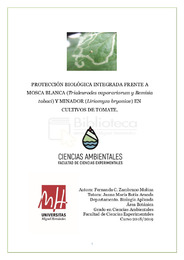Please use this identifier to cite or link to this item:
https://hdl.handle.net/11000/27056Full metadata record
| DC Field | Value | Language |
|---|---|---|
| dc.contributor.advisor | Botía Aranda, Juana María | - |
| dc.contributor.author | Zambrano Molina, Fernanda Carolina | - |
| dc.contributor.other | Departamentos de la UMH::Biología Aplicada | es_ES |
| dc.date.accessioned | 2022-05-11T13:27:30Z | - |
| dc.date.available | 2022-05-11T13:27:30Z | - |
| dc.date.created | 2019-07-11 | - |
| dc.identifier.uri | http://hdl.handle.net/11000/27056 | - |
| dc.description.abstract | Los cultivos de tomate, al igual que otros tipos de cultivos, están expuestos a una serie de plagas y enfermedades que pueden poner en peligro la producción creando importantes daños económicos y medioambientales. En este trabajo nos centramos en la plaga del minador (Liriomyza bryoniae) en un cultivo de tomates de producción BIO y por otra parte en las plagas de moscas blancas o aleurodes (Trialeurodes vaporariorum y Bemisia tabaci ), desarrolladas en cultivos NO BIO, ambos tipos de cultivo se realizan en invernadero. Este tipo de especies de insectos son las plagas más comunes dentro del cultivo del tomate y la Protección Biológica Integrada (PBI) se utiliza para controlar la población de estas especies plaga mediante el control biológico utilizando otras especies auxiliares como: Eretmocerus eremicus, Macrolophus pygmaeus, Encarsia formosa, Amblyseius swirskii y Diglyphus isaea. | es_ES |
| dc.description.abstract | Tomato crops, like other types of crops, are exposed to a series of plagues and diseases that can endanger production, creating significant economic and environmental damage. In this work we focus on the plague of the miner (Liriomyza bryoniae) in a crop of tomatoes of BIO production and on the other hand in the plagues of white flies or aleurodes (Trialeurodes vaporariorum and Bemisia tabaci), both developed in greenhouse crops NOT BIO. This type of insect species are the most common pests within the tomato crop and the Integrated Biological Protection (PBI) is used to control the population of these plague species through biological control using other predatory species, including: Eretmocerus eremicus, Macrolophus pygmaeus, Encarsia formosa, Amblyseius swirskii y Diglyphus isaea. | es_ES |
| dc.format | application/pdf | es_ES |
| dc.format.extent | 38 | es_ES |
| dc.language.iso | spa | es_ES |
| dc.publisher | Universidad Miguel de Hernández de Elche | es_ES |
| dc.rights | info:eu-repo/semantics/openAccess | es_ES |
| dc.rights.uri | http://creativecommons.org/licenses/by-nc-nd/4.0/ | * |
| dc.rights.uri | http://creativecommons.org/licenses/by-nc-nd/4.0/ | * |
| dc.subject | plagas | es_ES |
| dc.subject | protección biológica | es_ES |
| dc.subject | mosca blanca | es_ES |
| dc.subject | minador | es_ES |
| dc.subject | pests | es_ES |
| dc.subject | biological protection | es_ES |
| dc.subject | whitefly | es_ES |
| dc.subject | miner | es_ES |
| dc.subject.other | CDU::5 - Ciencias puras y naturales::50 - Generalidades sobre las ciencias puras::504 - Ciencias del medio ambiente | es_ES |
| dc.title | Protección biológica integrada frente a mosca blanca (Trialeurodes vaporariorum y Bemisia tabaci) y minador (Liriomyza bryoniae) en cultivos de tomate | es_ES |
| dc.type | info:eu-repo/semantics/bachelorThesis | es_ES |

View/Open:
TFG Zambrano Molina, Fernanda Carolina.pdf
2,43 MB
Adobe PDF
Share:
.png)
